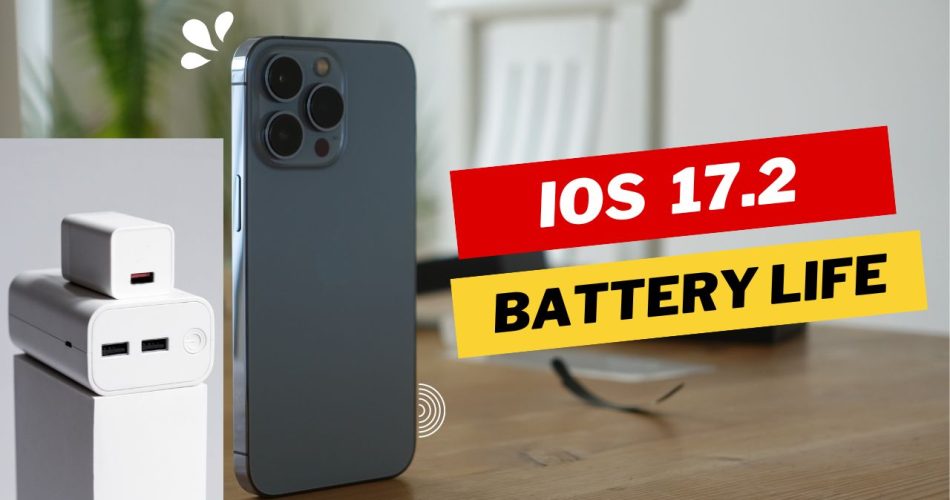The arrival of iOS 17.2 has been met with excitement and anticipation, as users eagerly update their devices to experience the latest features and improvements from Apple.
However, amidst the new capabilities and enhancements, some users have encountered a common concern: diminished battery life.
If you’re among those who have noticed a quicker drain on your device’s battery since updating to iOS 17.2, let’s go through a series of steps to help you optimize your battery performance and extend its lifespan.
What Is the Initial Battery Drain
When you first install a new iOS update, it’s not uncommon to experience a temporary decrease in battery life. This phenomenon is acknowledged by Apple and can be attributed to the system’s background activities, such as re-indexing and system recalibration, which are necessary for the update to integrate seamlessly with your device. Typically, this process may take a few days, during which you might notice a more rapid battery depletion. It’s important to exercise patience during this initial phase.
Keep Apps Up to Date
One of the first steps in addressing battery life issues is to ensure that all your apps are up to date. Developers often release updates to optimize their apps for the latest iOS version, which can include improvements in energy efficiency. You can manually update your apps via the App Store or enable automatic updates in your settings to streamline this process.
Customize Notifications and Haptics
iOS 17.2 introduces the ability to customize notification alerts and haptic feedback. While these features enhance personalization, they can also impact battery life, especially if you create custom haptics with extensive vibration. To conserve energy, consider using the default notification and haptic settings.
Manage Live Activities
The new Live Activities feature allows for real-time updates from apps, such as sports scores or delivery tracking. While useful, this feature can be a significant battery drain, particularly if you enable more frequent updates. If you prefer to keep Live Activities active, it’s advisable to disable the more frequent updates option.
Disable Unnecessary Background Processes
In the realm of augmented reality (AR), iOS 17.2 offers an “Improve AR” setting that, while intended to enhance the AR experience, operates in the background and can consume battery power. Turning off this setting can help conserve energy without significantly impacting your user experience.
AirDrop and AirPlay Settings
iOS 17.2 introduces “Name Drop,” a feature that facilitates device discovery for AirDrop. Additionally, the update allows your iPhone to act as an AirPlay receiver. Both features, while innovative, can lead to increased battery usage. If you don’t regularly use these functions, consider disabling them to save battery life.
Weather Widgets and Battery Consumption
The addition of new weather widgets provides detailed weather updates directly on your home screen. However, these widgets can be active continuously, updating information and using your location services, which can lead to increased battery usage. Be selective with the widgets you use, especially those that require frequent updates.
Identify Power-Hungry Apps
A practical step in battery optimization is to identify and monitor apps that consume significant amounts of power. The Battery section in your settings provides insights into which apps are using the most battery, allowing you to make informed decisions about which apps to keep or replace.
Screen Time and Eye Strain Reduction Features
iOS 17.2 offers a feature designed to reduce eye strain by encouraging users to hold their devices at a safer distance. While beneficial for eye health, this feature requires constant monitoring and can drain the battery. If you’re confident in your habits, you may choose to disable this feature.
Wi-Fi vs. Cellular Data
Using Wi-Fi instead of cellular data is a well-known method for conserving battery life. Cellular data, especially 5G, can be more demanding on your battery, so it’s wise to connect to Wi-Fi whenever possible. Additionally, adjusting your cellular settings to “5G Auto” can help balance performance and battery usage.
Haptic Feedback Settings
The vibration engine in your iPhone is another component that requires a considerable amount of power. By adjusting your haptic feedback settings to only play in silent mode, you can reduce unnecessary energy consumption while still receiving tactile notifications when needed.
Close Apps and Background App Refresh
Contrary to popular belief, frequently closing apps from the app switcher can lead to increased battery usage, as reopening these apps requires more power. It’s better to let iOS manage app suspension efficiently. Additionally, disabling background app refresh for apps that don’t need to update in the background can save battery life.
“Hey Siri” and Other Accessibility Features
The “Always Listen for ‘Hey Siri'” setting keeps your iPhone constantly alert for the activation phrase, which can drain the battery. If you don’t use this feature often, turning it off can help conserve power. Similarly, other accessibility features like Sound Recognition and Back Tap, if not needed, should be disabled to prevent unnecessary battery usage.
Embrace Dark Mode and Auto-Brightness
Dark mode is particularly beneficial for OLED screens, as it turns off pixels that display true black, thereby saving battery life. Using dark mode, especially on newer iPhones with OLED displays, can contribute to better battery performance. Auto-brightness is another feature that adjusts screen brightness based on ambient light, which can help extend battery life.
Manage Notifications
Notifications can be a significant drain on your battery, as they frequently activate your screen. To mitigate this, consider customizing your notification settings, using the Scheduled Summary feature for non-essential apps, and limiting active notifications to those that are truly important. While iOS 17.2 brings a host of new features and improvements, it’s essential to be mindful of the settings and features that can impact your battery life. By following the tips outlined above, you can optimize your device’s performance and enjoy the benefits of the latest iOS update without compromising on battery longevity. Remember, small adjustments can lead to significant improvements in your daily device experience.

